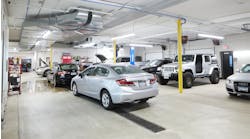Increasing the average repair bill without losing customer trust
Many shops undervalue their skills, and it can be reflected in the average repair bill. In today's environment, it is more important than ever to charge appropriately for the work being performed in order to keep shops profitable. Richard Counihan with DigniFi talks with Motor Age about the need to raise your average repair bill and how to do it while maintaining consumer trust.
Tell us about DigniFi and how it works with the consumer.
DigniFi is an embedded finance platform that connects consumers with lenders for trade assist, car repairs, tires, accessories and other auto-related needs. The automated, contactless process serves up financial products through the point of sale at car dealerships and independent repair shops.
How do you think the distrust and stigma of being overcharged has grown in the industry?
Although there is a perceived stigma of being overcharged in the industry, the real issue is that customers are often presented with an unexpected expense that they are in many cases unable to afford at the time and human nature looks to explain financial weakness by looking at other factors. DigniFi exists because we break this unexpected expense into small, monthly payments.
You also have to break down repairs into two parts — the parts and the labor. On the labor side, dealerships and independents are pretty competitive. When it comes to the parts, though, dealerships often use manufacturer parts which are more expensive, but are more likely to last longer than the parts independent repair shops use. Either way, it’s really the communication of the costs choices that matters and can help reduce distrust.
What can shops do to better educate their staff on how to communicate with consumers?
The dealers and their staff have done a great job in using multi-point inspection tools to show in an easily digestible manner what needs to be done on a car. However, time and time again we see consumers defer important maintenance and repair items not realizing the consequence of that decision will increase overall costs. The other area for improvement is that there are now ways to pay for these expenses by making small monthly payments.
What can shops do to better educate their customers on the reality of diagnostics and repair costs?
Most shops are using diagnostic tools and predetermined labor codes to determine the cost of a repair. The idea of an individual making pricing decisions detrimental to the consumers becomes harder and harder to do. That’s not to say that that it doesn’t happen, but the days of replacing an unnecessary part are waning. The biggest challenge for mechanics and service writers is explaining that the technology in the car is expensive to replace when it breaks. We love all the safety features but not the cost of replacement.
How can shops increase the average repair bill without losing customer trust?
Oftentimes, an automobile has a number of issues when it comes into a repair shop. Because of budget, many consumers choose to fix the most urgent issues, but leave the things that are less pressing off, even if the long-term damage might be more expensive. With access to a platform like DigniFi, more consumers choose to make a larger amount of the recommended repairs. Through open communication of the cost of replacement parts and labor, along with discussing the safety risks deferring car repair pose with the customer, and giving customers access to on-demand loans, shops can build trust and ensure all repairs that are needed get done.



